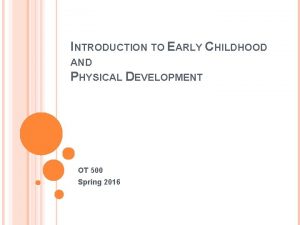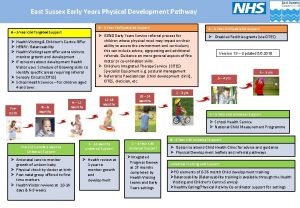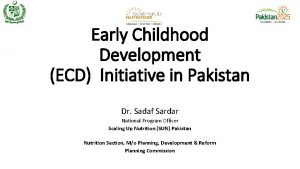Country years Early Childhood Development ECD Support for


- Slides: 2

Country year(s) Early Childhood Development (ECD) Support for Learning Early childhood, which spans the period up to 8 years of age, is critical for cognitive, social, emotional and physical development. During these years, a child’s newly developing brain is highly plastic and responsive to change. Optimal early childhood development requires a stimulating and nurturing environment, access to books and learning materials, interactions with responsive and attentive caregivers, adequate nutrients, access to good quality early childhood education, and safety and protection. All these aspects of the environment contribute to developmental outcomes for children. Early Stimulation & Responsive Care 100 87 Percent 80 55 60 40 16 20 0 Father Mother Any adult household member Percentage of children age 2 -4 years with whom the father, mother or adult household members engaged in activities that promote learning and school readiness during the last three days Note: Activities include: reading books to the child; telling stories to the child; singing songs to the child; taking the child outside the home; playing with the child; and naming, counting or drawing things with the child Attendance at Early Childhood Education Programmes 100 85 76 80 61 Percent Children facing a broad range of risk factors including poverty; poor health; high levels of family and environmental stress and exposure to violence, abuse, neglect and exploitation; and inadequate care and learning opportunities face inequalities and may fail to reach their developmental potential. Investing in the early years is one of the most critical and cost-effective ways countries can reduce gaps that often place children with low social and economic status at a disadvantage. 59 68 63 65 59 60 45 38 40 18 20 0 Total Girls Boys Age 3 years. Age 4 years Rural Urban Percentage of children age 3 -4 years attending an early childhood education programme, by background characteristics Region with lowest highest attendance Poorest Richest Key Messages • • • Lorem ipsum dolor sit amet, consectetuer • adipiscing elit, Lorem ipsum dolor sit amet, consectetuer adipiscing elit, sed diam nonummy nibh euismod tincidunt ut laoreet dolore • magna aliquam erat volutpat. Ut wisi enim ad minim veniam, quis nostrud exerci tation ullamcorper suscipit lobortis nisl ut aliquip ex ea commodo consequat. Duis autem vel eum iriure dolor in hensed diam Lorem ipsum dolor sit amet, consectetuer adipiscing elit, sed diam nonummy nibh • euismod tincidunt ut laoreet dolore magna aliquam erat volutpat. Ut wisi enim ad minim veniam, quis nostrud exerci tation ullamcorper suscipit lobortis nisl ut aliquip ex ea commodo consequat. Duis autem vel eum iriure dolor in hennonummy nibh euismod tincidunt ut laoreet dolore magna aliquam erat volutpat. Ut wisi enim ad minim veniam, quis nostrud exerci tation ullamcorper suscipit lobortis nisl ut aliquip ex ea commodo consequat. Duis autem vel eum iriure dolor in hen

Learning Materials & Child Supervision Access to Play & Learning Materials Inadequate supervision of children Region 3 or more children's books 50 2 or more types of playthings 55 Toys from a shop/ manufactured toys 87 Household objects/ objects found outside 65 Homemade toys 25 0 20 40 60 80 100 Left in inadequate supervision National 5 Region 1 3 Region 2 3 Region 3 3 Region 4 2 Region 5 2 Region 6 8 Regions 7&8 10 Region 9 21 Region 10 5 Percentage of children under age five according to their access to play and learning materials Percentage of children under age five left alone or under the supervision of another child younger than 10 years of age for more than one hour at least once in the last week, by region Early Childhood Development Index (ECDI) ECDI: Total Score & Domains, SDG 4. 2. 1 ECDI: Disaggregates National [CELLRANGE], 100 [CELLRANGE], [VALUE] [VALUE] 56 Physical 97 Learning 95 Social-emotional 75 Literacy-numeracy 20 40 60 [CELLRANGE], [VALUE] [CELLRANGE], [VALUE] 60 40 20 63 0 Percent 80 [CELLRANGE], [VALUE] 0 80 100 Area of residence Wealth Quintile Maternal education Sex of child Age of child ECE attendance Percent ECDI: Early Childhood Development Index; percentage of children age 3 -4 years who are developmentally on track in literacy-numeracy, physical, social -emotional, and learning domains The Country Multiple Indicator Cluster Survey (MICS) was carried out in 2014 by the National Bureau of Statistics as part of the global MICS programme. Technical support was provided by the United Nations Children’s Fund (UNICEF). UNICEF and Name of other organizations providing financial support provided financial support. ECDI by various characteristics ECE = early childhood education Note: Data for children whose mother has no education are based on 25 -49 unweighted cases. The objective of this snapshot is to disseminate selected findings from the Country MICS 2014 related to Early Childhood Development (ECD). Data from this snapshot can be found in tables TC. 10. 1, LN. 1. 1, TC. 10. 2, TC. 10. 3 and TC. 11. 1 in the Survey Findings Report. Further statistical snapshots and the Survey Findings Report for this and other surveys are available on mics. unicef. org/surveys.



